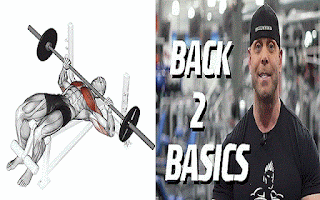Everyone who reads this has one thing in common: we've all been novices at some point. Some of you may be new to the game right now. We all learnt the basic moves when we first started working out, regardless of our fitness level. Even if you're training at an advanced level or for a different sport, returning to basic exercises like the barbell bench press can help you reach new heights in personal fitness.
David Baye, the social media director for FLEX magazine, will go through these classic lifts again so you can master them and push your body to the next level. The flat barbell bench press is the first exercise in this "Back 2 Basics" series.
EXERCISE ON THE FLAT BARBELL BENCH PRESS
Lee Haney, an eight-time The bench press, according to Mr. Olympia, is a "bread and butter" exercise. It's most recognized as one of the "big three" lifts in powerlifting, but it's also useful for bodybuilders. Although it's largely a chest movement, your anterior head of shoulders and triceps will benefit as well. As a result, those places will realize their own benefits.
WHO SHOULDN'T PRESS THE BENCH?
Anyone with shoulder problems or mobility limitations, according to Baye, should avoid doing this exercise. "The bench press may not be the optimal chest workout for you if you have shoulder mobility concerns or have had a past pec injury." If you have a pec injury, shoulder injury, or mobility difficulty, you should consult a doctor or physical therapist before performing the bench press."
THE USE OF THE RIGHT FORMAT IS ESSENTIAL.
Although most experienced lifters are aware of this, newbies should be aware as well. If you want to accomplish muscle growth while limiting the danger of injury, you must use proper form and execution. Putting plates on for the sake of ego boosts or presuming you know what you're doing without guidance won't help your cause.
Hand Position — On the bar, your hands should be broader than shoulder width apart. Powerlifters may go super-wide to reduce their range of motion. It's best to go a little wider for muscular training, which is what this is all about. Going narrow can help your triceps, which will be discussed later. Most bars feature rings that you can use as a reference to assist you figure out where you should put your hands.
Elbows – When you unrack the bar and start descending, keep your elbows tucked in. They should also stay in while you're pressing. Bench pressing with the elbows out has caused many pec injuries in bodybuilders. If you keep your elbows in, you'll be less likely to experience a same fate.
Range of Motion - We've all seen people who drop the bar halfway or shift it a few inches away from their chest. Shortcuts like these won't help you in the long run. Bouncing the bar off your chest and generating momentum isn't going to help you build your pecs. It's a good idea to barely contact the bar on your chest and then press back up to your starting position.
Back Arch and Foot Positioning– You should have a little arch in your back, but not a big arch like you might see in some online videos. Your feet should be roughly shoulder-width apart and flat on the floor. Bays recommends putting plates on the floor and putting your feet on them if you have shorter legs.
SPOTTERS
Baye is using light weight in the video for teaching purposes, but he does recommend having someone with you when you start going heavier. "Having a spotter is always essential, especially with bench press, because when you get caught, you may really get stuck." You can have one spotter behind you to unrack the weight or have teammates on both sides of the bar ready to assist if needed.
AN EXAMPLE OF A CHEST ROUTINE WITH THE BENCH PRESS
Baye has provided a sample regimen for novices to try. There are two warmup sets indicated, but feel free to complete as many as you need before starting your work sets. Within the prescribed rep range, all work sets should leave you on the point of failure.
Back 2 Basics Barbell Bench Press Workout
Flat Barbell Bench Press
*2 warmup sets of 8-10 reps 3-4 Sets 8-10 reps
Incline Dumbbell Press 3-4 Sets 8-10 reps
Cable Crossover 3-4 Sets 8-10 reps
Dumbbell Pullover 3-4 Sets 8-10 reps


Commentaires
Enregistrer un commentaire